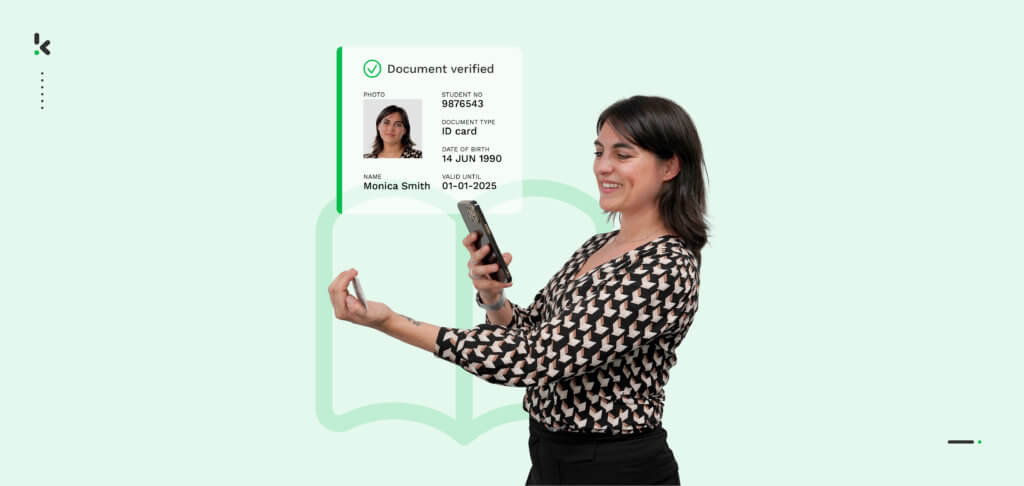

During the pandemic outbreak, schools and universities had to adapt to the requirement of social distancing, leading to the closure of physical educational institutions and their replacement with online platforms.
As e-learning and remote studying became widely accepted, the focus shifted to ensuring the legitimacy of online education. From preventing cheating on online exams to tackling misuse of student discounts, the need for robust identity verification has become crucial.
Yet, the challenge widely remains unaddressed. Educational fraud is treated as a bump in the road, while in the back of things, it is drawing out millions in revenue.
In our strategic approach to address this challenge, we will look at various student identity verification methods, find out their advantages and limitations in different use cases, and lead you to a seamless solution for optimizing ID verification within your business framework.
What is Student Identity Verification?
Traditionally, student identity verification has been a manual process aimed at confirming a student’s identity at different points in their educational journey. Whether for on-campus resource access or retail discounts, students typically scan or present their identity documents.
Recognizing that manual verification can be error-prone, fraudulent, and time-consuming, many companies are now transitioning to automated verification systems. This shift not only improves accuracy but also makes the verification process more efficient and secure, reducing the likelihood of inconsistencies.
However, institutions and corporations have different perspectives on the importance of preventing educational fraud, leading to a variety of verification methods being used.
How Does Student Identity Verification Work?
There are various verification methods to choose from, each with different security levels and steps for implementation. The wide range of options gives institutions and businesses the freedom to choose the most effective way to improve security and reduce risks.
Some of the identity verification solutions are:
- Student email verification. The student begins by submitting their school email address. Following this, the retailer or institution sends a verification e-mail containing a unique link that the student must click to verify their status as a student.
- University account verification. The student is taken to the University’s secure login page. After filling in the correct combination of email address/student number and password, the system provides access to the student.
- Identity document verification. Both e-mail and university account verification rely solely on passwords, making them easily accessible to anyone with the correct combination. The most secure and streamlined solution resides in student or government ID card verification. The user’s identity is verified by scanning or uploading the individual’s government or student ID card.
Yet, not all of these verification solutions offer a high level of security. By failing to implement secure and efficient identity document verification, educational institutions and companies leave themselves open to several vulnerabilities.
Why is an Automated Student Identity Verification Important?
With digitalization becoming increasingly widespread, the educational industry needs to adapt. Failing to do so poses a threat to academic institutions and companies, leaving them vulnerable to a host of security risks. These risks include:
- Identity fraud: Identity verification is vulnerable to the use of stolen identity documents. Unauthorized individuals can bypass manual identity verification procedures and gain access to educational resources and privileges. An automated solution, on the other hand, can detect forged and manipulated documents that may be challenging for the human eye to spot. Without a reliable solution, it becomes difficult to confirm if it was the actual student who completed coursework and earned a qualification.
- Resource drain: Manual verification methods are time-consuming and resource-intensive, leading to delays in granting access to educational materials and services. Automated systems streamline the verification process, ensuring efficiency and a smoother experience for both students and staff.
- Financial losses: An insecure student verification system can lead to significant financial losses. Companies often fail to realize the substantial financial losses caused by discount fraud.
However, the student identity verification solution not only mitigates risks but also offers multiple benefits that enhance operational efficiency for all stakeholders.
What are The Benefits of Student Identity Verification?


Streamlined student identity verification brings crucial advantages to the organization. The most common benefits are:
- Trust and Credibility: Identity verification develops a crucial level of trust between different stakeholders. Without an efficient verification process, verifying a student’s completion of course material becomes highly challenging.
- Regulatory compliance: Educational institutions are required to verify the identity of students. In the United States, the Department of Education’s Title IV regulations require verification of students who participate in distance education. Proof of identity ensures that the individual completing the course is indeed the actual student.
- Enhanced User Experience: Streamlined verification processes help to offer a smoother user experience for students and staff, reducing delays and errors.
Armed with insights into the risks and benefits of student identity verification, it’s important to explore the potential applications of this solution.
Student Identity Verification Use Cases
The use cases for student identity verification are diverse, ranging from university registration to applying for student retail discounts. It’s important to understand which applications and how a secure identity document verification solution can be implemented.
Student identity verification with government-issued ID cards
Government-issued ID cards or passports are mainly used when there’s no need for a pre-existing connection to an educational institution. These are often the initial stages of student enrollment, like applying to a university or college. Since the process is usually done only once, it’s important to make sure it’s done right.
The student registration process usually follows these few steps:
- The general process starts with an individual capturing or uploading their government ID.
- Then an OCR solution extracts information from the captured document and verifies it with the input information.
- Finally, if the information matches, the student is verified and can be enrolled in an institution.
While government ID card verification remains essential in the initial stages of educational practices, its use cases are limited beyond that point. The primary purpose of a student ID card is to eliminate the necessity for a government-issued one.
Student identity verification with student ID cards
Student ID cards are commonly used to verify access to exclusive services and restricted areas reserved solely for students. These cards combine proof of personal information and university affiliation, making them a versatile tool for students.
This solution serves as the key to unlocking entry into campus facilities, monitoring student attendance, gaining access to examination halls, navigating online portals, and various other privileges.
Among the branches of applications, student discount providers stand out as one of the most common. Consider NBA TV as an example. The company provides a 40% discount to individuals enrolled in educational institutions. The issues arise in verifying the student’s affiliation to an educational institute.
NBA TV’s verification process allows the use of personal email addresses and skips ID card verification, leaving no clear verification procedures in place. This flexibility weakens the exclusivity of the discount, making it accessible to everyone.
A more secure and accurate verification solution looks like this:
- First, when the student applies for the discount, he/she is asked to capture or upload their student ID card to the company’s website.
- Next, an OCR solution for student ID cards will extract the needed information from the document and compare it to the user’s initial input.
- Upon successful verification, the student is granted access to the discount.
However, the main problem is the lack of real-time visibility into discount fraud losses, as the absence of a solution makes it difficult to differentiate between genuine and fraudulent applicants. With the rise of the concern, Klippa has created a secure and streamlined solution for student identity verification.
Streamline Your Student Identity Verification with Klippa
Klippa’s DocHorizon offers identity verification powered by AI designed for educational institutions and student discount providers. In just minutes, Klippa efficiently extracts, converts, and categorizes various documents, simplifying the student verification process and enhancing security against educational fraud.
As previously discussed, verifying student identity through student and governmental ID card verification is a highly secure and efficient method. Klippa goes beyond with an inclusive solution, incorporating features such as:
- Biometric verification. Using AI algorithms, distinctive features such as voice and facial characteristics are cross-referenced with information on the governmental or student ID card, providing an added layer of security to grant access only to legitimate students.
- Klippa’s software seamlessly integrates with your educational institute or company website through our SDK and API.
- Klippa’s data anonymization safeguards sensitive student information, mitigating legal and privacy concerns.
For more information on how Klippa can benefit your business, feel free to reach out to us or schedule an online demo below.